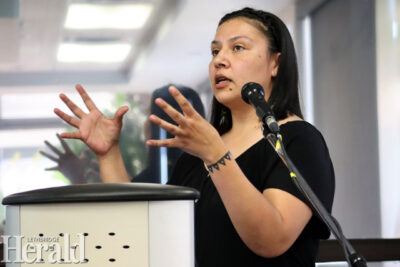Indigenous curator aims to expand focus of Galt Museum
By Theodora MacLeod LETHBRIDGE HERALD Local Journalism Initiative Reporter on August 5, 2023.
 Herald file photo
Camina Weasel Moccasin speaks about the Galt's Battle of the Belly River Project during as session of the Southern Alberta Council on Public Affairs.
Herald file photo
Camina Weasel Moccasin speaks about the Galt's Battle of the Belly River Project during as session of the Southern Alberta Council on Public Affairs.The Galt Museum and Archives is Lethbridge’s go-to for learning about southern Alberta’s rich human history. With a constantly growing collection of artifacts and archival records, the museum is dedicated to connecting visitors to the past.
Camina Weasel Moccasin is the first to hold the official role of Indigenous curator with the museum. Prior to the introduction of her position a year-and -a-half ago, guest curators were regularly invited to develop exhibits pertaining to Indigenous history.
This season, Fort Whoop-up – which is overseen by the Galt – has opened a gallery that focuses on the experiences of the Blackfoot people. The Niitsitapi gallery came in response to feedback from the community.
“One of the comments that we were getting from the community – and not just about that venue in particular, but museums and interpretive centres around the nation in general – was the way in which they talk about or refer to Indigenous communities,” Weasel Moccasin explains.
“The Blackfoot Elders were saying, ‘they always talk about us in the past as if we no longer exist, or that our way of life no longer exists.'”
In consultation with community leaders and Elders, the space was created to discuss the experiences and history of the Niitsitapi people more accurately. “When you enter this space, the biggest underlying message is that there’s these traditions and practices that have been going on for thousands of years are still being practiced today in the 21st century,” Weasel Moccasin says. “Even though Blackfoot people aren’t wearing hide, or have feathers in our hair, we’re still speaking the language, we’re still conducting our ceremonies, still living that traditional way of life.”
Weasel Moccasin says there are several upcoming exhibits at the museum itself, including a travelling exhibit called Escaping Residential Schools that will open in September.
Though the exhibit looks at the experiences of residential school survivors throughout Canada, the Galt is working with University of Lethbridge associate professor and member of the Kainai community, Tiffany Prete to develop a supplementary information focusing specifically on the impacts policies and the schooling system had on the Blood tribe.
In addition to the Niitsitapi gallery, Weasel Moccasin and her colleagues have recently spent time going through the program matrix at Fort Whoop-up and expanding the lens the history is approached with to include Indigenous experiences.
She says that in the past the perspective has been more that of the Euro-Canadian experience. New additions such as discussion around the impact new foods introduced by both newcomers to the Blackfoot people vice-versa allow them to “provide more variety of information and make it a more holistic understanding of the fort and the time that it had operated within.”
11-10


